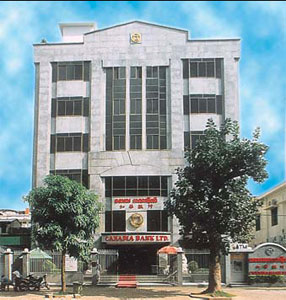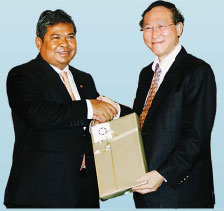Canadia Bank strives to promote brand Cambodia

Bringing its brand image under the spotlight is important to Canadia Bank, as it seeks to raise awareness about the brand, the bank and the good work it does, said Pung Sovann, general manager of Canadia Bank Plc, during an interview with China Daily.
Canadia Bank's profile
Canadia Bank was established on November 11, 1991 as Canadia Gold & Trust Corporation Limited as a single office financial institution managed by the former staff of the National Bank of Cambodia and Canadian Cambodian shareholders.
|
New head office of Canadia Bank, being built for completion in 2009 |
On April 19, 1993, the institution was approved as a commercial bank registered under the Ministry of Commerce and the National Bank of Cambodia and its name was changed to Canadia Bank Ltd. On December 16, 2003, the institution was renamed Canadia Bank Plc (Public Limited Company).
As the largest bank in Cambodia since its privatization in 1998, the bank has more than 23 overseas correspondent banks attracting about one quarter of national bank deposits and offering a broad range of financial services including personal, commercial, private and retail banking. It also has 22 branches located in the capital Phenom Penh and in major provinces. The Bank's strategic plan call for the opening of an additional 6 branches in the remaining 9 months of the year 2008 alone.
Canadia Bank Plc offers a complete range of products and services including commercial and mortgage loans, local and international funds transfer, trade finance, cash management, bank guarantee, money exchange and private banking services. Its esteemed customers include individuals, SME's and corporate clients, local and international non-profit organizations and large national and multinational companies.
Key achievements
With the country experiencing political and economic stability for a number of years, Canadia Bank began providing housing loans when other banks were still worried about such long-term commitments.
The bank was the first to take the risk of providing mortgages, which helped create more public trust in the banking sector.
In Cambodia, specifically in Phnom Penh, there are many squatters who occupy land without rights and many investors who want to invest in housing or commercial projects. Developers and middlemen need funds to purchase the land, negotiating financial agreement and relocation with the squatters and then develop the area.
Canadia was the first and only bank to lend to developers who had to deal with this unique situation, in spite of it being a high-risk step.
The bank charges a competitive interest rate for this special loan product, but once the developer has developed land thanks to Canadia bank's financing, he can then sell the land to investors for a much higher price. So it becomes a win-win situation for all involved, including the squatters, which in turn spurs the development of Cambodian property and infrastructure.
Role and influence
Canadia Bank not only caters to the wealthy who seek high returns. It also helps the people of Cambodia grow and become wealthy themselves.
|
Current head office of Canadia Bank in Phenom Penh |
In a situation of greater national stability, the bank started to extend rural loans to farmers, providing the money they needed to buy a cow or a water pump, or to make sure villages had a farm on which the village residents could work to make a living, although such projects are not huge successes in terms of financial returns for the bank.
Agriculture is not very profitable for the bank but it sees it as an important social service to Cambodia and the rural population.
The bank makes its profits from helping the three key pillars of the Cambodian economy. The three pillars are the garment, tourism and construction industries. Canadia provides finance to garment factories and hotels, including hotel developments in Siem Riep and Sihanouk Ville, which are major touristic areas.
Cambodia offers many opportunities for foreign investors to provide expertise, equipment and finances, especially expertise on renting or purchasing land. Canadia provides loans and assistance for such projects. It also helps finance the Canadia Industrial Park.
The bank is dedicated to step in wherever it can help encourage business and trade growth, as well as developmental work, even if the risks are higher than some other financial institutions would feel comfortable with. Canadia spreads its risks in such a way and has such in-depth knowledge of the market and all its players that it has come out as Cambodia's most profitable bank with the highest deposit and asset base. It continues to increase its lead on its competitors.
The National Bank is objective in its role as banking supervising institution and has a clear vision of what's best for the banking and finance industry. Through the Association of Banks, Canadia tries to support the National Bank as best it can for the sake and future of the banking sector.
Investment from China
Many times Canadia introduces local businesses to investors. It has spent a lot on advertising Canadia's services in China. The bank has good contacts with the commercial department of the Chinese Embassy in Phnom Penh. They also worked many hours together to create and issue the Cambodia Investment Guide in Chinese. Canadia has pledged to do all it can to help bring investors to Cambodia and brief them in detail about investment opportunities in the country.
|
Mr Chea Chanto, governor of National Bank of Cambodia, shakes hands with Mr Pung Sovann, general manager of Canadia Bank and chairman of the Association of Banks Cambodia at the Annual Association of Bank's Dinner in December 2007. |
Chinese investments in Cambodia so far have mostly come from the government or State-owned companies operating in Cambodia, such as road construction firms. But till recently, the Chinese private sector was unwilling to take risks with investing in Cambodia, so there has been little to no private investment up to date.
However, though the Chinese private sector was slow to enter Cambodia, the process has recently begun. A large house development project in Phnom Penh, worth about $100 million, is being financed by private Chinese investors.
Most Chinese investors in Cambodia, for example those in the hydropower and the special economic zone projects, are clients of Canadia Bank.
The Canadia brand is very strongly geared towards attracting Chinese investors. The bank's consultancy department for foreign investors provides advice on how to set up a company, how to buy land or lease land from the government, how to receive licenses and get in touch with experts in different areas of Cambodian business and with the Council for the Development of Cambodia (CDC). The consultancy department can be a big help to Chinese investors.
The department's advice and consultation services are provided free to investors interested in working with Canadia.
The quality of Cambodian human resources is a major issue for foreign investors. A great deal of work has been done to train staff effectively. The niche market is dealing with Chinese speaking investors and 30 percent of Canadia staff can communicate in Chinese.
Strategic Partnerships
Canadia does need strategic partners and international connection, as the image of local banks in Cambodia is still not high.
Multinational companies and NGOs prefer to work with banks in Cambodia, who have an international background (such as international shareholders or head offices). Consequently, all local banks are reviewing and developing their international strategic partnerships. Canadia knows what the problems and weaknesses are. Furthermore, Canadia has a clear and an optimistic outlook on the future.
The bank tells NGOs that they have a very wide branch network and provide great quality service for a very competitive price, along with a wide range of supporting services.
Canadia knows although the local people support them, internationally people look for a widely recognized brand. As one of its future challenges, Canadia will look for ways to make local banks internationally known, which is where strategic partnerships can help.
(China Daily 04/10/2008 page27)

















